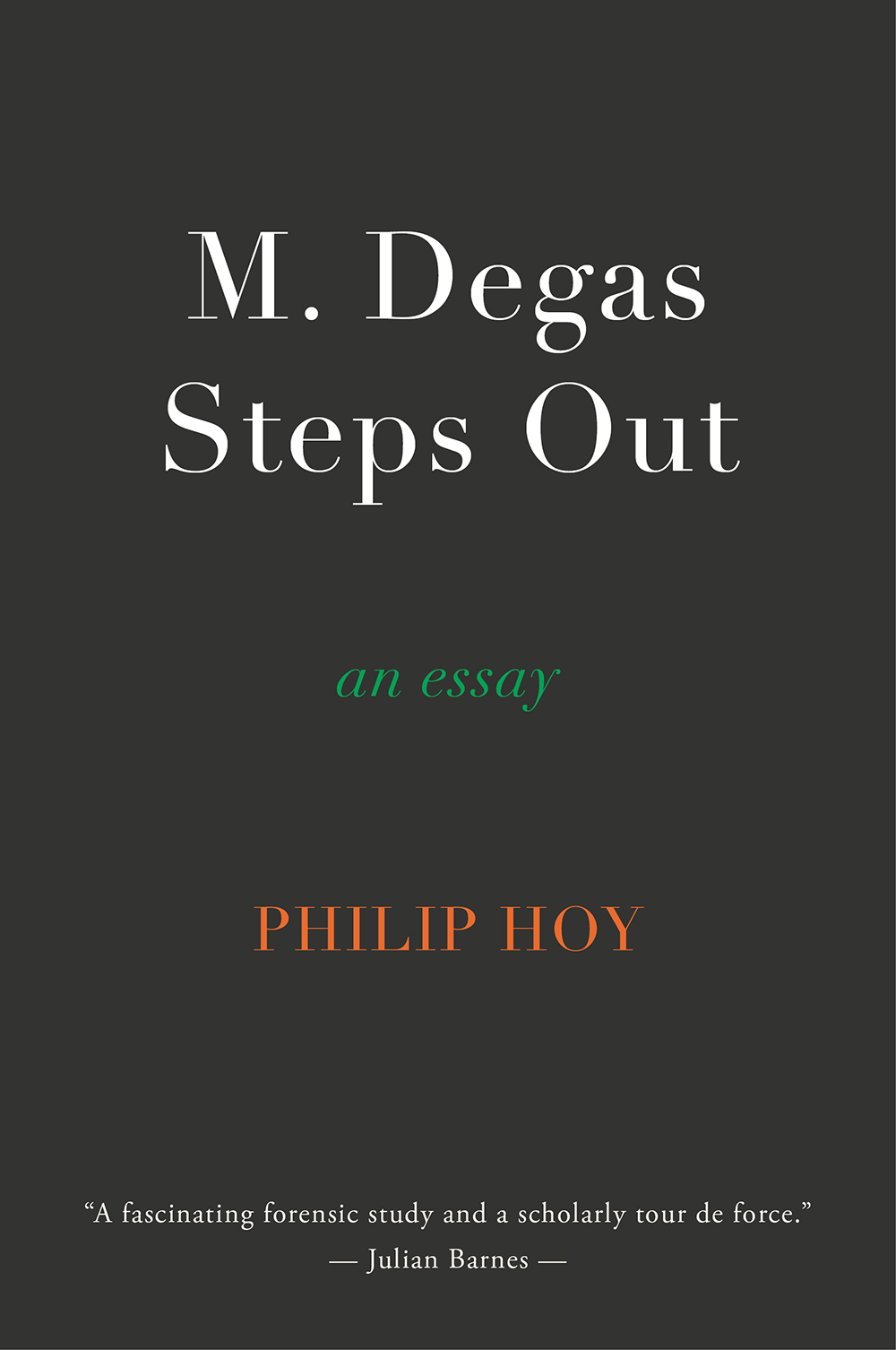M. Degas Steps Out
£14.99
In the autumn of 2011, I went to see Degas and the Ballet, an exhibition which had recently opened at the Royal Academy in London’s Piccadilly. Long an admirer of Degas’s art, I cherished this opportunity to see so many of his works – not far short of one hundred paintings, sculptures, pastels, drawings, and prints, as well as a number of the photographs he had taken in his later years. Although the exhibition was everything I could have hoped for, and more, my most vivid memory is not of the works on display, but of a grainy sequence of black and white film which was being shown in the exhibition’s last room. The sequence was very short, running for a mere nine seconds, but it was being played on a continuous loop, and I sat and watched it again and again, totally mesmerized. A notice to one side explained that the central figure in the sequence – a bowler-hatted man walking along a busy Parisian street, accompanied by a much younger woman – was the artist whose exhibition we had just visited. I don’t recall if it said anything else.
Thus begins M. Degas Steps Out, Philip Hoy’s painstakingly researched, engagingly written, and thought-provoking essay, an essay in which he not only tells us how this fugitive bit of film came to be made but also seeks to correct mistakes about it which have entered the accounts of earlier commentators – biographers, art historians, even the film-maker himself. Then, in a fine postscript, Hoy addresses himself to the question of what it is about this film that is so captivating, enticing us to watch it not just once or twice, but repeatedly.
M. Degas Steps Out
A fascinating forensic essay, and a scholarly tour de force.
— Julian Barnes
Philip Hoy’s writing is excellent, his sleuthing persuasive, and his conclusion packs a punch. M. Degas Steps Out is likely to be of no little interest to Degas scholars and aficionados.
— Neil Berry
What a wonderful piece of work! I can’t say how much I loved this utterly original book. The author looks long and hard at nine seconds of pedestrian film much as a good art historian looks at a great painting, and by truly interrogating it — analysing every gesture, every glance, every turn of the head — he succeeds in transforming each of the many anonymous figures we see into a person with a past, a future, a profession, an interest. The complexity of it all is mind-expanding. M. Degas Steps Out is the best thing I’ve read in years.
— Richard Dorment
Philip Hoy’s protracted examination of a mere nine seconds of film of the aged Edgar Degas walking towards us down a Paris street has the effect of waking us up to the utter strangeness of human life and of the mysterious power of photography and film. Haunting.
— Gabriel Josipovici, Emeritus Professor of English, University of Sussex
“Delicious … Beautifully written.
— Phillip Lopate
A truly remarkable piece of work, this beautifully written essay proves to be as affecting as it is enthralling. Hoy is best known as a publisher and editor, but in these pages he steps out as an equally brilliant author. M. Degas Steps Out deserves to find a wide readership.
— Jonathan Post, Distinguished Research Professor of English, University of California, Los Angeles
Philip Hoy fully justifies spending so many pages on a mere 9 seconds of historical event. An exemplary piece of forensic research becomes, through his handling of it, an utterly absorbing story.
— Christopher Reid
I haven’t read a stranger, more original book in a very long time. It’s a wonder. I suspect that M. Degas, lover of privacy that he was, would have been delighted by the book, which it’s an understatement to call an ‘essay’.
— Sherod Santos, Emeritus Professor of English, University of Missouri
An engrossing treat: Philip Hoy’s M. Degas Steps Out examines a short illicit film of Degas in his old age and turns it into an absorbing quest.
— Miranda Seymour
What a superb essay — a thrilling page turner and a powerfully moving memento mori. I love Hoy’s patient attention to detail, the way he looks, then looks again, and in describing what he sees dramatizes as vitally as possible the pastness of the past, its vanishing immediacy. A fabulous and riveting piece.
— Alan Shapiro, William R. Kenan, Jr. Distinguished Professor of English and Creative Writing, University of North Carolina at Chapel Hill
M. Degas Steps Out is a triumph of patience and perseverance, observation and speculation, research and imagination, in an ekphrastic genre that as far as I know Philip Hoy has invented. His profound meditation involves exegeses of stills from a nine-second silent, black-and-white film of an aging Edgar Degas taking the air on a Parisian Boulevard. Hoy’s animation of these stills conjures another dimension altogether from that of the ‘movie.’ It makes one think now of Sebald, now of Proust.
— Stephen Yenser, Distinguished Research Professor of English, University of California, Los Angeles
Reviews of M. Degas Steps Out
The Observer (January 29, 2023)
Bianca Stigter’s recent documentary Three Minutes: A Lengthening is based on a short home movie taken by an American tourist in the Polish town of Nasielsk in 1938. The same section of film appears again and again, accompanied by commentary and testimonies, slowed down, zoomed in on and freeze-framed. Yet these everyday images of Jewish life acquire an extraordinary poignancy because we know that almost everyone on screen will soon be caught up and killed in the Holocaust … Something of the same spirit pervades Philip Hoy’s striking essay-length book M. Degas Steps Out. When he went to an exhibition of Edgar Degas in 2011, he became ‘totally mesmerised’ by a nine-second film clip of the ageing painter walking down a Paris street. So he downloaded it on to his computer, slowed it down and broke it up into 250 stills, 42 of which are included here … By subjecting this tiny sequence to intense analysis, Hoy shows how it reflects a tragic turning point in French life. Early in the first world war, the actor and playwright Sacha Guitry put together a short propaganda film showcasing leading figures in French culture. Friends such as Sarah Bernhardt and Claude Monet were happy to perform for the camera, but when Degas grumpily spurned his approaches Guitry was obliged to film him surreptitiously … When we realise we are looking at wartime Paris, Hoy suggests, we start to notice the absences. The city has been ‘feminised’, with more women than men out and about. Only a soldier and one other man appear to be of military age. And the once busy streets are now empty of traffic, since most vehicles were requisitioned by the army … But what about the unknown figures glimpsed momentarily and then lost for ever? Could the soldier be one of the tiny minority stationed in Paris or granted a short period of leave – and was he among the 1.4 million French people who perished in the war? Could the four women in ankle-length outfits be entertainers, Hoy wonders, or perhaps some of the city’s 6,000 registered sex workers coming home from ‘Leave Land’, near the Gare du Nord, which, according to one historian, would shortly witness ‘an explosion in open-air sex’? Why is the gawping young man on a triporteur or delivery tricycle not away at the front? And what, if anything, can we read into an ephemeral glance? … Although he has clearly read widely on the social history of Paris, Hoy admits that much of his essay amounts to ‘idle speculation’ but he has certainly woven a beguiling tapestry around it.
Matthew Reisz
To read the whole of this review, go to: https://www.theguardian.com/books/2023/jan/29/m-degas-steps-out-an-essay-by-philip-hoy-review-an-artistic-encounter-across-a-century





